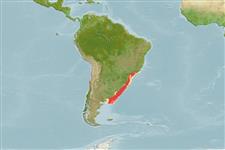Common names from other countries
Classification / Names / Names
Nomes comuns | Sinônimos | Catalog of Fishes (gen., sp.) | ITIS | CoL | WoRMS
Environment: milieu / climate zone / depth range / distribution range
Ecologia
; Água doce; intervalo de profundidade 4 - 200 m (Ref. 83435). Tropical, preferred 18°C (Ref. 107945); 23°S - 42°S, 74°W - 42°W
Southwest Atlantic and Southeast Pacific: From Rio de Janeiro, Brazil to San Matiás Gulf, Argentina. In the Pacific it is found in Chile. Tropical to subtropical.
Length at first maturity / Tamanho / Peso / Idade
Maturity: Lm ?, range 12 - 13 cm Max length : 27.0 cm DL macho/indeterminado; (Ref. 83435)
Minimum depth range from Ref. 122063. Lives in shallow waters at maximum depths of 4 m during low tide. Found on sandy subtrates with boulders and sponges. Individuals spend most of their time buried. Females attach their egg capsules to benthic hard substrata such as mollusk shells and/or pebbles (Ref. 122063). Voracious predator on bivalves (Ref. 114777).
Life cycle and mating behavior
Maturidade | Reprodução | Desova | Ovos | Fecundidade | Larvas
This species is a non-broadcast spawner. Life cycle does not include trocophore stage. Also Ref. 833.
SAUP Database. 2006. (Ref. 356)
Status na Lista Vermelha da IUCN (Ref. 130435)
Status no CITES (Ref. 108899)
Not Evaluated
Not Evaluated
Uso pelos humanos
Pescarias: espécies comerciais
FAO - pescarias: landings | FishSource | Sea Around Us
Ferramentas
Fontes da internet
Estimates based on models
Preferred temperature
(Ref.
115969): 19.5 - 21.2, mean 20 (based on 9 cells).
Resiliência
Médio, tempo mínimo de duplicação da população 1,4 - 4,4 anos (K=0.21; tm=8.5).
